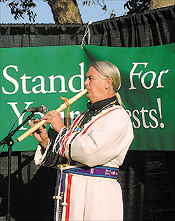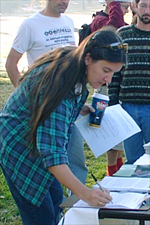|
By Jenny Coyle and John Rosapepe
It's the largest unprotected roadless area in the Lower 48. More than 280 miles of river flow through its rhyolite canyon walls that rise 400 to 1,000 feet high. It has some of the largest juniper forests on the North American continent, with trees more than 1,000 years old. And it's home to one of the last intact sagebrush ecosystems.
Few Americans have heard of the 9-million-acre Owyhee Uplands and Canyonlands in southwest Idaho, southeast Oregon and northwest Nevada, but it's one of 40 sites the Sierra Club is working to protect through the Environmental Public Education Campaign, or EPEC.
In EPEC, Club chapters receive special funding to work locally on community issues. Each site holds high-profile outreach events in the fall and spring, and events vary with each location.
Over two weekends in October, more than 125 Idahoans - two dozen of them students from area environmental clubs - went door to door, tabled and in other ways distributed 12,000 pieces of literature in Boise, Twin Falls and the Wood River Valley, urging recipients to send postcards to public officials to help protect the Owyhee.
Meanwhile, Nebraska Chapter volunteers set up a booth outside the Cornhusker homecoming game on Oct. 20. They handed out 2,700 postcards for football fans to send in to Gov. Mike Johanns, asking him to take the lead on setting and enforcing standards for massive animal factories in the state. Their booth featured a giant "report card" detailing health, safety and water-quality violations by the factories that sell meat to the U.S. school lunch program.
"Some people signed the postcards on the spot, and we'll send those into the governor," said Laura Krebsbach, Nebraska conservation organizer. "But most people were in a big hurry to get to their seats, so they took the cards with them to mail in later."
Don't want to get in the way of a Cornhusker fan.
That same day, activists in the Georgia Chapter held a "Stand Up for the Trees" rally featuring flute music and storytelling by Native American John Winterhawk Johnson.
 |
John "Winterhawk" Johnson played music and gave a Native American perspective on trees at the "Stand Up for Your Forests" rally in Atlanta, Ga., in October. The fall outreach event - part of the Sierra Club's Public Environmental Education Campaign - kicked off the Georgia Chapter's project to protect roadless areas and end commercial logging in the Chattahoochee and Oconee national forests. |
Dave Muhly, the EPEC organizer for Georgia and other states in the southern Appalachian region, is working to protect roadless areas and end commercial logging on federal lands. At the rally in Atlanta, a seminarian gave a benediction to the Sierra Club's work on the issue, and a legislative aide to Rep. Cynthia McKinney (D-Ga.) - a co-sponsor of legislation to end commercial logging on federal lands - praised the group's work.
 "Restoration, not logging, is the better means to economic security for our rural communities," said Muhly. Volunteers spent the afternoon distributing several thousand postcards urging Sen. Zell Miller (D-Ga.) to protect forests. "Restoration, not logging, is the better means to economic security for our rural communities," said Muhly. Volunteers spent the afternoon distributing several thousand postcards urging Sen. Zell Miller (D-Ga.) to protect forests.
And still on that very same autumn Saturday, in Minnesota - where forest protection is also the focus - volunteers distributed 5,000 postcards by tabling and going door to door in Duluth, Grand Marais and Ely. More than 2,000 households were contacted in Stillwater, and 4,000 postcards were delivered in Minneapolis and St. Paul.
The following weekend, activists did their own bit of forest protection by "bud capping" in white pine forests.
"Especially in winter, deer love to feed on white pine bud tops, seriously damaging the trees," explained organizer Joe Hesla. "We staple a small piece of cardboard or paper onto the top sprig of the tree - the deer are free to eat other buds on the tree. Protecting the lead bud allows the tree to keep growing taller until bud-capping is no longer necessary."
John Rosapepe, who contributed to this story, is a Northern Rockies (Idaho) Chapter volunteer.
Photos courtesy Dave Muhly
Up to Top
|